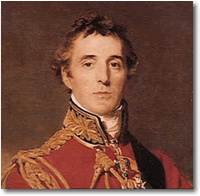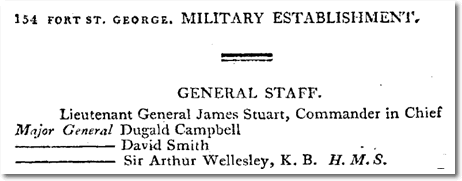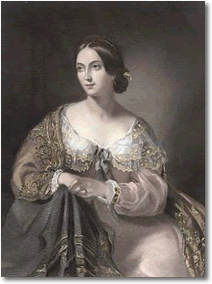
The 1st Duke of Wellington was born Arthur Wesley in Dublin 1769. The fourth son of five, his parents were Garret Wesley, 1st Earl of Mornington and Anne Hill, the eldest daughter of Arthur Hill, Viscount Dungannon. Arthur Wesley joined the army in 1787, and proposed to Catherine Sarah Dorothea Pakenham in 1793. His marriage proposal was rejected by the Pakenham family who felt that his prospects were poor.
Arthur then threw himself into his military career fighting against the French in Flanders, and joined his brother Richard in India in 1796. Richard Wesley was the Governor General of India in 1797. The new Diamond Premium subscriptionon TheGenealogist includes overseas records for India, America, South Africa, and Australia. Records for India include the 1805 East India Register and Directory, which mentions both Arthur and his brother Richard, now known as Wellesley after the family changed their name in 1798.

Arthur’s military career was extremely successful and he was appointed Chief Secretary for Ireland in 1807. However the role was short lived as he returned to the army the same year to resume the fight against the French.

After being knighted for his military success, Arthur proposed again to Catherine Pakenham in 1806 and her family gave their approval. He married Catherine in April 1806 and they had two children Arthur and Charles. However after all his efforts to secure the marriage, Arthur found that he and Catherine were not very compatible and as a result spent much time away from his family, concentrating instead on his military and political career.
During the Peninsular War of 1808 to 1814 he led the British, Portuguese and Spanish forces, pushing the French out of Spain and Portugal. He returned home in 1814 to a hero’s welcome and was awarded the title Duke of Wellington. This is recorded in the ‘Knight’s of England’ dataset on TheGenealogist which details titles and honours awarded during the years 1127 to 1904.
The entry gives details of the title being initiated whilst still in Portugal, and formally receiving the honour in 1814. It also states his year of death. Arthur is mentioned again in later years receiving the Order of the Bath and the Order of the Guelphs of Hanover following his victory over Napoleon at the Battle of Waterloo in 1815.
Access Over a Billion Records
Try a four-month Diamond subscription and we’ll apply a lifetime discount making it just £44.95 (standard price £64.95). You’ll gain access to all of our exclusive record collections and unique search tools (Along with Censuses, BMDs, Wills and more), providing you with the best resources online to discover your family history story.
We’ll also give you a free 12-month subscription to Discover Your Ancestors online magazine (worth £24.99), so you can read more great Family History research articles like this!

In 1818, the now Duke of Wellington turned his attention to his political career and was given a post in Lord Liverpool’s Tory government. In 1827 he was made Commander in Chief of the British Army and became Prime Minister for the Tory party in 1828. The Duke believed in a strong authoritative government and often annoyed members of his party, particularly when he forced through the Catholic Emancipation Act in 1829, which allowed Catholics to sit in the House of Commons.
He earned the nickname ‘Iron Duke’ after putting iron shutters on his windows at Apsley House, considered one of the finest houses in London, to prevent them being smashed by angry crowds. Using the House and Street search on TheGenealogist, entering ‘Apsley House’ in London 1851 shows the Duke at residence with his 14 servants. TheGenealogist has complete census records for England and Wales from 1841 to 1901, available to all Premium and Personal Plus subscribers. All forth-coming census releases will be available exclusively in their new Diamond Premium.
The Duke’s government fell from power in 1830 but returned in 1834. The Duke declined the position of Prime Minister in favour of Robert Peel and instead served as Foreign Minister from 1834 to 1835. He retired from politics in 1846 and spent the last years of his life at Walmer Castle in Kent, as Lord Warden of the Cinque Ports, and died in 1852 age 83. His body was taken back to London for a state funeral and he is buried in St Paul’s Cathedral next to Lord Nelson.
His will, recorded in 1818, is available in the PCC Wills collection on TheGenealogist. There are over 1 million records in the Prerogative Court of Canterbury wills and probate collection, which covers the years 1384 to January 1858. The records are copies of registered wills, which were written into volumes by the clerks at the church courts, and many earlier records are in Latin. TheGenealogist now has over 140 years’ worth of wills available online, bringing the total number of records to nearly 700,000.






